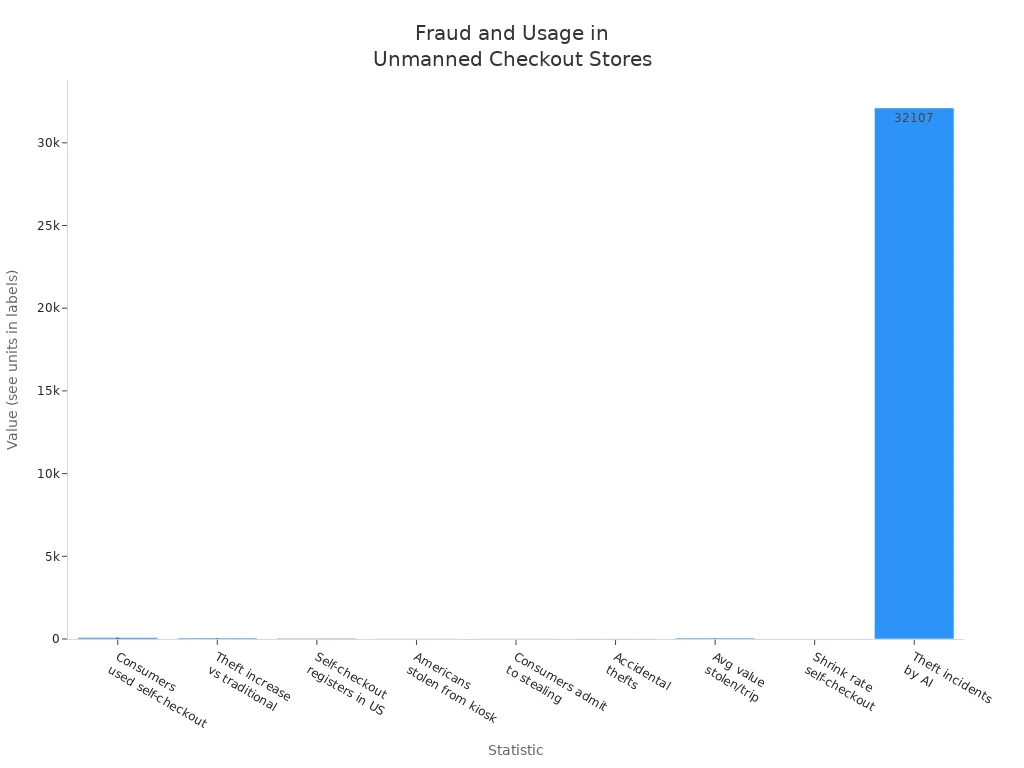Ai fraud detection for unmanned checkout

Imagine you walk into an unmanned store, pick up your favorite snack, and check out without speaking to anyone. This convenience brings new risks. Theft and accidental mistakes happen more often in self-checkout environments. Stores use ai to watch for fraud and keep everyone honest.
Statistic | Value |
|---|---|
Percentage of consumers who have used self-checkout machines | |
Increase in theft at self-checkout compared to traditional checkouts | 65% |
Percentage of grocery store registers in the U.S. that are self-checkout kiosks | 40% |
Number of Americans who have stolen from a self-checkout kiosk | 20 million |
Percentage of consumers admitting to using self-checkout to steal | 15% |
Percentage of self-checkout thefts that are accidental | 21% |
Average value of items stolen in one trip | $60 |
Shrink rates with self-checkout as a percentage of average retailer inventory | 3.75% |
Theft incidents identified by AI models | 32,107 |

You rely on ai fraud detection to spot suspicious activity instantly. These smart systems protect your shopping experience and help businesses build trust.
Key Takeaways
AI fraud detection enhances your shopping experience by monitoring transactions in real time, ensuring safety and reducing theft.
Real-time monitoring systems use smart cameras and sensors to catch suspicious actions instantly, helping prevent both theft and accidental mistakes.
Pattern recognition allows AI to learn your shopping habits, flagging unusual behavior for further review, which helps maintain security.
Anomaly detection identifies actions that deviate from normal patterns, allowing stores to catch fraud early and protect customer information.
Continuous improvement of AI systems is essential; regular updates and staff training ensure effective fraud detection and a secure shopping environment.
AI Fraud Detection

Real-Time Monitoring
You want your shopping experience to be safe and smooth. Real-time monitoring helps make this possible in unmanned stores. AI fraud detection systems use smart cameras and sensors to watch every part of the store. These cameras use advanced algorithms to spot suspicious actions, like someone hiding an item or skipping the checkout process. When the system sees something unusual, it sends an alert right away. This quick response helps stop theft before it happens.
AI tracks your movements and matches them with your virtual cart. This way, the system knows if you pick up an item and forget to scan it. Stores use real-time monitoring with AI, computer vision, and RFID technology to keep track of both customers and products. This approach can reduce shrinkage by up to 30% by 2030. You benefit from a safer store, and businesses lose fewer items to theft.
Tip: Real-time monitoring does not just catch theft. It also helps prevent mistakes, like forgetting to scan an item.
Pattern Recognition
AI fraud detection relies on pattern recognition to tell the difference between normal and suspicious behavior. The system looks at your transaction history, device details, and shopping habits. It learns what is typical for you and other shoppers. If someone tries to buy a lot more than usual, makes many failed logins, or changes account details suddenly, the system notices these outliers.
AI image recognition tools can even spot fake products by checking logos and packaging for small differences. Predictive analytics look at your past shopping to find odd patterns, like a sudden big purchase. The system assigns a risk score to each transaction. If the score is high, the system flags it for review.
AI systems analyze transaction histories and spending patterns.
They spot outlier activities, such as rapid repeat transactions or purchases from new locations.
AI image processing checks for counterfeit products.
Predictive analytics highlight unusual shopping behavior.
Real-time analytics flag suspicious financial transactions.
AI fraud detection uses machine vision to compare your actions with huge databases of both normal and fraudulent behaviors. Unlike people, AI does not get tired and can check every detail, every time.
Anomaly Detection
Anomaly detection is a key part of ai fraud detection. The system looks for anything that does not fit the usual pattern. It uses machine learning models to spot these odd events. Some models work with labeled data, while others find outliers without any labels. This makes the system flexible and powerful.
Here are some common machine learning models used for anomaly detection:
Model Type | Description |
|---|---|
Supervised Learning | Uses labeled data to train models, identifying known fraud patterns with algorithms like decision trees and SVM. |
Unsupervised Learning | Detects outliers without labeled data, using algorithms like k-means clustering and isolation forests. |
Semi-supervised Learning | Combines labeled and unlabeled data for more efficient anomaly detection, useful when labeled data is limited. |
Isolation Forest | Isolates data points through random partitioning, flagging those needing fewer partitions as anomalies. |
Autoencoders | Neural networks that reconstruct input data, identifying anomalies as points with poor reconstruction. |
Clustering Algorithms | Groups data points into clusters, flagging anomalies that do not fit into any cluster. |
Statistical Methods | Uses mathematical models to detect deviations from expected patterns, employing techniques like z-scores. |
AI fraud detection systems use these models to spot chargeback fraud, card testing fraud, identity verification issues, and account takeovers. By catching these problems early, the system keeps your information and the store’s assets safe.
Note: Anomaly detection works best when the system keeps learning from new data. This way, it can spot new types of fraud as they appear.
Technologies in Unmanned Store Systems

Computer Vision
You see computer vision at work every time you enter unmanned store systems. This technology uses smart cameras to watch how you move and interact with products. AI analyzes your actions, looking for signs of theft or mistakes. For example, if you forget to scan an item, computer vision can spot it right away. Some stores use systems like Truscan, which track shoppers and alert staff if someone tries to leave without paying for everything. Computer vision also helps recognize products and checks for fake items by comparing logos and packaging. With these tools, unmanned store systems move from just watching to predicting and stopping fraud before it happens.
Computer vision enables visual pattern recognition and behavioral analysis.
AI-driven cameras detect unscanned items and alert staff.
Retailers use computer vision for real-time, cost-effective fraud detection.
Machine Learning
Machine learning gives unmanned store systems the power to learn from your shopping habits. AI models study your behavior, such as how you pick up and scan items. These models spot unusual actions, like hiding a product or scanning the same item many times. Machine learning also uses data from sensors and cameras to find patterns that may signal fraud. The system can even combine different types of data, such as movement and transaction records, to improve accuracy.
Application Area | Description |
|---|---|
Uses data from cameras, sensors, and transactions to find odd patterns in real time. | |
Behavior Analysis Framework | Watches how you interact with products to catch hidden scanning or theft. |
You benefit from this technology because it helps keep your shopping safe and fair.
Data Analytics
Data analytics brings all the information together in unmanned store systems. AI reviews transaction data, camera feeds, and sensor inputs to spot risks. Predictive analytics help stores see when theft might happen and take action before it does. Real-time monitoring means the system can send alerts to staff if it notices something strange. Pattern recognition tools look for odd shopping behaviors, like someone moving quickly through the store or picking up many high-value items at once.
Type of Analytics | Description |
|---|---|
Predictive Analytics | AI predicts possible security threats and helps stores act early. |
Real-time Monitoring | The system watches store activities and spots suspicious behavior right away. |
Advanced Pattern Recognition | AI finds unusual patterns and alerts staff to possible fraud. |
Sensors and cameras track your movements and product interactions. AI processes this data to make sure your experience is smooth and secure. By using these technologies, unmanned store systems protect both you and the business from fraud.
AI in Unmanned Stores
Use Cases
You see ai working in unmanned stores every day. When you pick up an item, cameras and sensors track your actions. If you forget to scan something, the system can spot it and send an alert. Some unmanned stores use ai to match your movements with your virtual cart, making sure you pay for everything you take. In other cases, ai checks for fake products by looking at logos and packaging. Large retail chains use ai to watch hundreds of unmanned stores at once, keeping security strong across all locations. These systems help you shop quickly and safely.
Effectiveness
Ai brings many benefits to unmanned stores. You get instant alerts if something goes wrong, which helps stop theft right away. Ai can predict problems before they happen, so stores can act early. You also enjoy a smooth shopping trip because ai works quietly in the background. Stores save money because they do not need as many workers to watch for theft. The table below shows some key benefits:
Benefit | Description |
|---|---|
Real-Time Response | Instant alerts and automated responses reduce loss windows from days to seconds. |
Proactive Prevention | Predictive fraud detection anticipates threats before they materialize. |
Scalability Across Locations | Manages and analyzes security data from hundreds of stores in real time, applying consistent policies. |
Reduced Operational Costs | Automation minimizes the need for human monitoring, leading to cost savings and efficiency gains. |
Enhanced Customer Experience | Discreet threat identification ensures a frictionless shopping experience while maintaining security. |
Challenges
Unmanned stores face some tough challenges when using ai. Sometimes, the system does not understand why you make certain choices, which can lead to mistakes. If the data used to train ai is not good enough, the system might miss new types of fraud. Building strong data systems takes time and skill. You may also worry about privacy because ai watches your actions. Stores must follow privacy laws and explain how they use your data. Fraud tactics change all the time, so ai must keep learning to stay ahead. Here are some common challenges:
Ai may not understand the human context behind your actions, which can cause false alarms.
The quality of training data affects how well ai works in unmanned stores.
Privacy concerns grow as ai systems collect and analyze more data.
Ethical and legal questions arise when ai makes decisions without clear reasons.
Fraud tactics keep changing, so ai must adapt quickly.
Note: Unmanned stores must balance strong security with respect for your privacy and trust.
Implementation Steps
Assess Needs
You should start by looking at your store’s unique risks. Think about the size of your store, the number of products, and how many people shop there each day. List the types of fraud you want to stop, such as theft, fake returns, or missed scans. Ask yourself what data you already collect, like video footage or transaction records. This step helps you set clear goals for your ai fraud detection system.
Tip: Talk to your staff and customers to learn about common problems in your store.
Choose Solutions
Next, you need to pick the right technology. Compare different ai tools that fit your needs. Some systems use cameras and sensors, while others focus on analyzing payment patterns. Look for solutions that work well with your current equipment. You can use a table to compare features:
Solution Type | Main Feature | Works With Existing Tech? |
|---|---|---|
Camera-Based | Tracks movement | Yes/No |
Sensor-Based | Detects product scans | Yes/No |
Payment Analytics | Spots odd payments | Yes/No |
Choose a solution that matches your budget and store layout.
Integrate Systems
After you choose your ai system, connect it with your store’s cameras, sensors, and checkout software. Test the system to make sure it tracks products and customers correctly. Train your staff to use the new tools and respond to alerts. Good integration means your ai system can spot fraud in real time.
Monitor and Improve
You need to watch your system’s performance every day. Major retailers like Amazon and Alibaba use their own ai systems to check millions of transactions for fraud. Walmart uses machine learning to find strange payment patterns as they happen. Update your algorithms and retrain your models when you see new types of fraud or if the system misses problems. This keeps your store safe and your ai system strong.
Review alerts and flagged transactions often.
Update your ai models with new data.
Test your system after every update.
Ask for feedback from staff and customers.
Note: Continuous improvement helps you stay ahead of new fraud tricks.
AI fraud detection helps you shop safely in unmanned stores. These systems watch transactions in real time, spot suspicious actions, and automate risk checks. You get better security and faster service. New tools like explainable AI and federated learning protect your privacy while keeping stores safe. In the future, you will see smarter checkout systems, stronger identity checks, and even quantum-resistant security. AI will keep making unmanned shopping safer and easier for everyone.
FAQ
How does AI know if you are stealing or just making a mistake?
AI watches your actions with cameras and sensors. It compares what you do to normal shopping behavior. If you forget to scan an item, the system can tell the difference between an accident and theft by looking at your patterns.
Will AI systems keep your personal data safe?
Most stores use strong security to protect your information. They follow privacy laws and limit who can see your data. You can ask the store how they use and store your data.
Can AI make mistakes and accuse you wrongly?
Yes, AI can sometimes make errors. It might flag normal actions as suspicious. Staff review alerts to check for mistakes. You can always ask for help if you think the system made a wrong call.
What should you do if the system flags your transaction?
Stay calm and ask a staff member for help. They can review the alert and fix any problems. Stores want to make sure you have a fair and safe shopping experience.
See Also
Understanding Self-Checkout Cash Mistakes and Their Fixes
Common Issues Faced at Walmart's Self-Checkout Stations
How Self-Checkout Systems Have Developed Over Time
Walgreens Self-Checkout: Benefits and Obstacles for Shoppers
